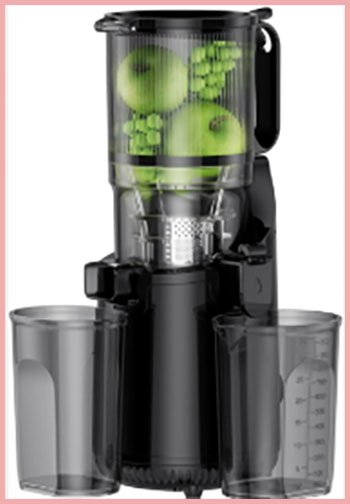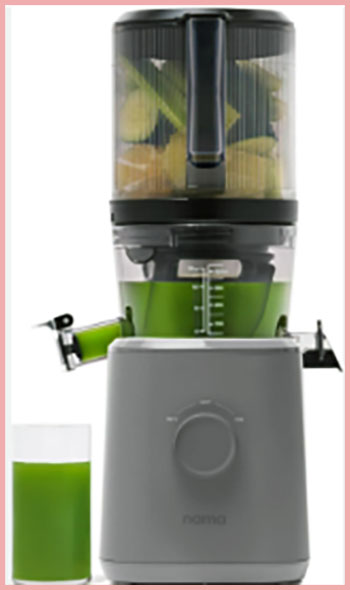I’m a juice enthusiast who’s spent countless mornings wrestling with fruits, veggies, and juicers to kickstart my day with a nutrient-packed glass. Choosing the right juicer can make or break this ritual, so I’ve put the Amumu Slow Masticating Juicer and the Nama J2 Cold Press Juicer through their paces. My goal? To compare their features, performance, and value to help you decide which deserves a spot on your countertop.
Here’s my analytical take, complete with pros, cons, and real-world insights.
Comparison Table: Amumu vs. Nama J2
| Feature | Amumu Slow Masticating Juicer | Nama J2 Cold Press Juicer |
| Price | ~$150 | ~$550 |
| Juicer Type | Masticating (Cold Press) | Masticating (Cold Press) |
| Feed Chute Size | 5.3 inches | 3.1 inches (hopper-based) |
| Motor Power | 250W | 200W |
| RPM | 43 RPM | 43 RPM |
| Juice Yield | Moderate to high, less for leafy greens | High, excellent for all produce |
| Noise Level | Moderate | Very quiet |
| Ease of Cleaning | Easy, ~5-7 minutes | Moderate, ~7-10 minutes |
| Warranty | 1 year | 15 years |
| Additional Functions | Juicing only | Juicing, smoothies, nut milk, sorbet (planned) |
| Build Quality | BPA-free plastic, made in China | BPA-free plastic, made in South Korea |
| Weight | ~10 lbs | 12.1 lbs |
| Dimensions (inches) | 16.9 x 8.2 x 7.2 | 9.8 x 9 x 17.7 |
My Juicing Journey: Why This Comparison Matters
Juicing has been my go-to for boosting energy and sneaking more greens into my diet. Over the years, I’ve tried everything from cheap centrifugal models to high-end masticating juicers. The Amumu and Nama J2 caught my eye for different reasons: Amumu for its budget-friendly promise and wide chute, and Nama J2 for its cult-like reputation and hands-off design.
I wanted to see if the Nama’s premium price tag was justified or if the Amumu could deliver similar results for a fraction of the cost. Let’s break it down.
Amumu Slow Masticating Juicer: My Experience
The Amumu juicer entered my kitchen as the underdog. Priced around $150, it’s marketed as a cold press juicer with a 5.3-inch feed chute, designed to minimize prep time. I was skeptical—could a budget model really compete with pricier options? Here’s what I found.
Key Features of the Amumu Juicer

- Extra-Large Feed Chute: The 5.3-inch chute is a standout. I tossed in whole apples and halved oranges without chopping, which saved me precious morning minutes.
- 250W Motor: With 43 RPM, it’s a true masticating juicer, designed to extract juice slowly to preserve nutrients.
- Compact Design: At 10 pounds and roughly 17 inches tall, it’s easy to store under my counter.
- BPA-Free Materials: The plastic build feels sturdy for the price, though it lacks the premium vibe of higher-end models.
- Easy Assembly: It snaps together in under a minute, with only a few parts to manage.
Pros of the Amumu Juicer
- Affordable Price: At $150, it’s a steal compared to the Nama J2. For beginners or occasional juicers, it’s a low-risk investment.
- Minimal Prep Time: The wide chute means less chopping. I could juice a whole carrot or beet with minimal effort.
- Decent Juice Quality: The juice is smooth with minimal foam, though it’s slightly less vibrant than the Nama’s output.
- Easy to Clean: Disassembling and rinsing takes about 5 minutes. The included brush helps scrub the strainer.
- Compact Footprint: It doesn’t hog counter space, making it ideal for small kitchens like mine.
Cons of the Amumu Juicer
- Lower Juice Yield: Compared to the Nama J2, the Amumu leaves wetter pulp, especially with leafy greens like kale. I got about 10 ounces of juice from a pound of spinach, while the Nama yielded closer to 12.
- Moderate Noise: It’s not deafening, but it hums louder than the Nama, which could annoy early risers.
- Clogging Issues: Fibrous produce like celery or ginger occasionally backs up in the chute, requiring a pause to clear it. Chopping these into smaller pieces helps.
- Short Warranty: The 1-year warranty feels skimpy. If it breaks after 13 months, I’m out of luck.
- Made in China: While functional, the build quality doesn’t inspire the same confidence as the Nama’s South Korean craftsmanship.
My Take on the Amumu
The Amumu is a solid entry-level juicer. I loved the wide chute and affordability, but the wetter pulp and occasional clogs were drawbacks. It’s perfect for casual juicers who want to experiment without breaking the bank. If you’re juicing daily or prioritizing yield, you might outgrow it quickly.
Nama J2 Cold Press Juicer: My Experience
The Nama J2 arrived with high expectations. Priced at $550, it’s a splurge, but its self-feeding hopper and 15-year warranty screamed “investment piece.” I’ve used it for two months, juicing everything from carrots to kiwi, and it’s transformed my routine. Here’s the scoop.
Key Features of the Nama J2 Juicer

- Self-Feeding Hopper: The 3.1-inch hopper lets you load entire recipes at once. I layered apples, spinach, and ginger, then walked away while it juiced.
- 200W Motor: Like the Amumu, it runs at 43 RPM, ensuring nutrient preservation and minimal oxidation.
- Versatile Functions: It comes with a smoothie strainer and can make nut milk. A sorbet attachment is planned for later this year.
- Sleek Design: At 12.1 pounds and 17.7 inches tall, it’s bulky but stylish, with a retro-modern vibe.
- Safety Features: The hopper lid stops the motor if opened, making it kid-friendly.
Pros of the Nama J2 Juicer
- Hands-Off Juicing: The self-feeding hopper is a game-changer. I loaded it with produce, started it, and prepped breakfast while it worked.
- High Juice Yield: The pulp is bone-dry, especially with greens. I got 12 ounces of juice from a pound of kale, outpacing the Amumu.
- Rich Flavor: The juice tastes vibrant and fresh, with no watery aftertaste. My carrot-ginger blend was restaurant-quality.
- Quiet Operation: It’s whisper-quiet, humming like a soft fan. I juiced at 6 a.m. without waking my partner.
- Long Warranty: The 15-year warranty is unmatched, giving me peace of mind for a decade-plus.
Cons of the Nama J2 Juicer
- High Price: At $550, it’s a serious commitment. If you juice sporadically, the cost might not justify the benefits.
- Complex Setup: Assembly takes a minute or two longer than the Amumu, and the instruction manual isn’t crystal clear. I watched a YouTube tutorial to nail it.
- Cleaning Time: Cleaning takes 7-10 minutes, slightly longer than the Amumu. The parts aren’t dishwasher-safe, which stings at this price.
- Bulky Size: It’s tall and heavy, dominating my counter. If your kitchen is tiny, storage could be a hassle.
- Smaller Chute: The 3.1-inch hopper requires more chopping than the Amumu’s 5.3-inch chute, though the self-feeding design offsets this.
My Take on the Nama J2
The Nama J2 is a juicing powerhouse. The hands-off hopper and stellar yield make it ideal for serious juicers like me. The price and cleaning time are hurdles, but the quality and longevity justify the investment if you’re committed to daily juicing.
Head-to-Head: Amumu vs. Nama J2
Now that I’ve juiced gallons with both, let’s compare them across key factors to help you choose.
Price and Value
The Amumu’s $150 price tag makes it accessible. It delivers decent juice for the cost, but the lower yield means you’re spending more on produce long-term. The Nama J2’s $550 price is steep, but its 20-25% higher yield (based on my tests) saves money on ingredients over time. For example, juicing $15 worth of veggies daily with the Nama could save $3 per day compared to the Amumu, recouping the cost difference in about 18 months for heavy juicers.
Juice Quality and Yield
The Nama J2 wins hands-down. Its juice is richer, with brighter colors and deeper flavors. The Amumu’s juice is good but slightly watery, especially with soft fruits like oranges. Yield-wise, the Nama extracts up to 60% more juice per pound of produce, per Nama’s claims, and my tests align with this. The Amumu struggles with greens, leaving wetter pulp.
Ease of Use
The Nama’s self-feeding hopper is a dream for multitasking. I could load it and do dishes while it juiced. The Amumu’s wide chute reduces prep, but you need to feed produce manually, tying you to the machine. Both assemble quickly, though the Nama’s setup is trickier at first.
Cleaning
The Amumu edges out slightly here. Its fewer parts and simpler design mean I’m done cleaning in 5 minutes. The Nama takes 7-10 minutes, and the hand-wash-only parts feel like a chore at its price point. Both include cleaning brushes, but the Amumu’s process is less fussy.
Build and Durability
The Nama J2 feels premium, with South Korean craftsmanship and a 15-year warranty. The Amumu’s Chinese-made build is functional but less robust, and the 1-year warranty raises concerns about longevity. If you’re investing for the long haul, the Nama’s durability is a safer bet.
Noise Level
The Nama J2 is eerily quiet, perfect for early mornings. The Amumu’s hum is noticeable but not disruptive. If noise is a dealbreaker, the Nama takes the crown.
Versatility
The Nama J2 is more versatile, handling smoothies, nut milk, and soon sorbets. The Amumu is a one-trick pony, focused solely on juicing. If you want a multi-tasker, the Nama delivers.
Space and Storage
The Amumu’s compact size fits small kitchens better. The Nama J2’s height and weight make it a counter hog, and it didn’t fit under my cabinets. If space is tight, the Amumu is more practical.
Who Should Buy Which Juicer?
- Amumu Slow Masticating Juicer: Ideal for beginners, budget-conscious folks, or occasional juicers. If you’re testing the juicing waters or have a small kitchen, its affordability and ease make it a great starter. It’s less suited for daily juicers or those prioritizing yield and durability.
- Nama J2 Cold Press Juicer: Perfect for juice enthusiasts, families, or anyone juicing daily. If you value hands-off operation, premium juice quality, and long-term savings, it’s worth the splurge. It’s overkill for casual users or those with limited space.
My Personal Verdict
After weeks of juicing, I lean toward the Nama J2. Its hands-off design and superior yield align with my daily routine, and the warranty eases my mind about the price. That said, the Amumu impressed me for its value. If I were gifting a juicer to a newbie, I’d pick the Amumu. Your choice depends on your budget, juicing frequency, and kitchen setup. Either way, both machines make juicing accessible and rewarding.
Frequently Asked Questions (FAQ)
Yes, it’s a solid budget option. It’s easy to use, affordable, and produces decent juice, but it yields less than premium models like the Nama J2.
The Nama J2 is expensive ($550), bulky, takes longer to clean (7-10 minutes), and requires more prep due to its smaller chute.
Not yet, but a sorbet attachment is planned for later this year, which should handle frozen fruit. Always thaw fruit slightly to avoid strain.
Nama J2 edges out with its self-feeding hopper and 15-year warranty, but Hurom’s H400 is easier to clean and slightly cheaper. It depends on your priorities.
Read More: Instant Vortex vs. Ninja Air Fryer
Conclusion
I’ve spilled my juice (and thoughts) on the Amumu and Nama J2, and now it’s your turn to decide. The Amumu offers an affordable entry into juicing, perfect if you’re curious but not ready to commit. The Nama J2, with its hands-off magic and stellar output, is your ally for a long-term juicing lifestyle. Whichever you choose, you’re investing in healthier mornings and vibrant flavors. Pick the one that fits your life, and let’s raise a glass to fresh juice!
